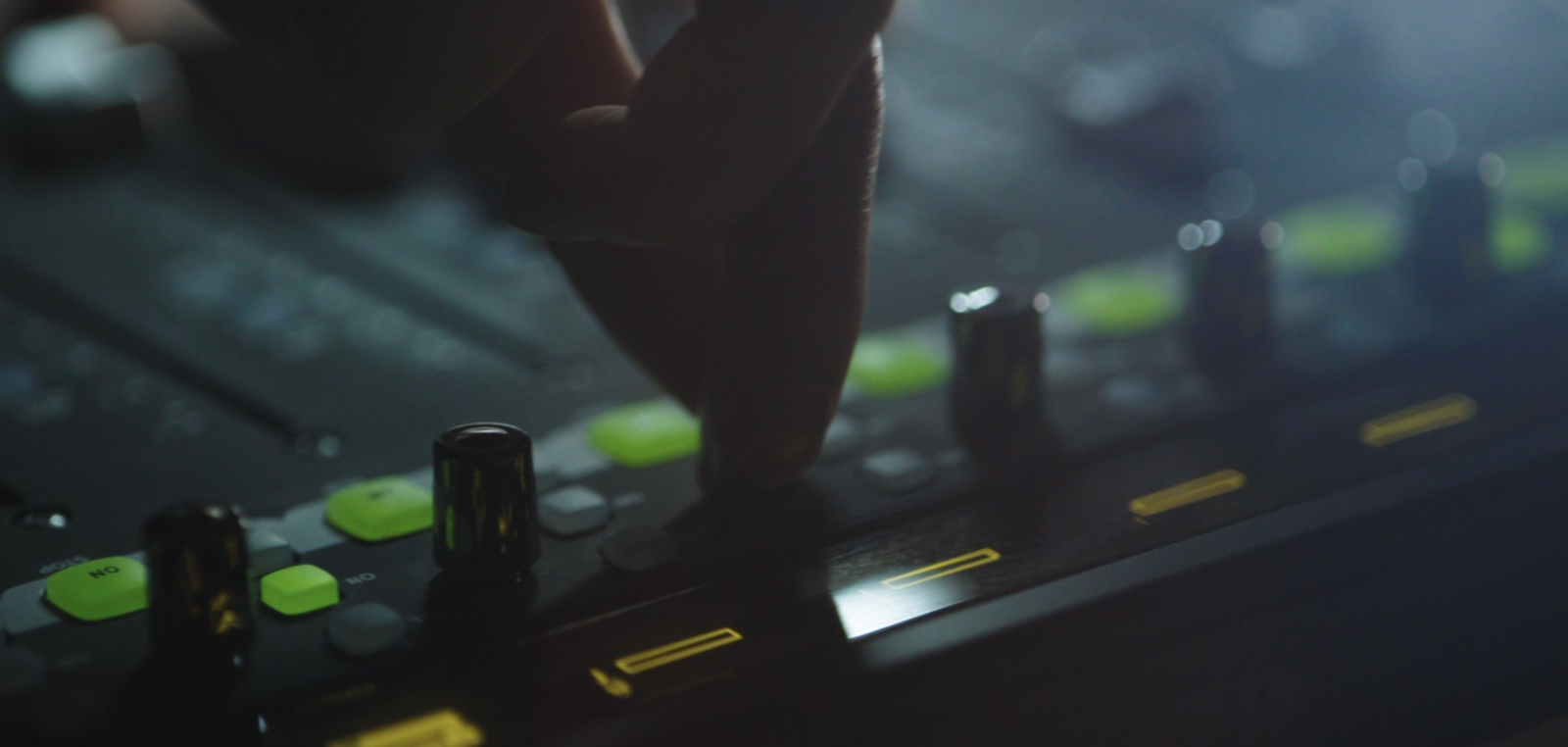
Over the last few months, we’ve been preparing and recording the dialogue lines for the three main characters. Like many other aspects of this project, this is my first time delving into this area of game development, and I had no idea of the amount of work and challenges we would find. Today I would like to share some of that process.
Character Voices
Unlike what it might feel like in the final product, the character design choices we made are all to serve the themes we are exploring. When I set out to create a ‘time loop narrative,‘ I didn’t have any specific story or characters in mind. We molded the characters to the game design restrictions, not the other way around.
So after we had the main gameplay and story beats defined, we started to build the backstory and motivations of the characters. Then we could finally focus on their voices, mannerisms, and how they interact.
We then scheduled a sit-down session with local actors to get a feeling for how these characters would register if they had a voice. We converted some parts of the story to script format, and let them go over them and see how it all felt.
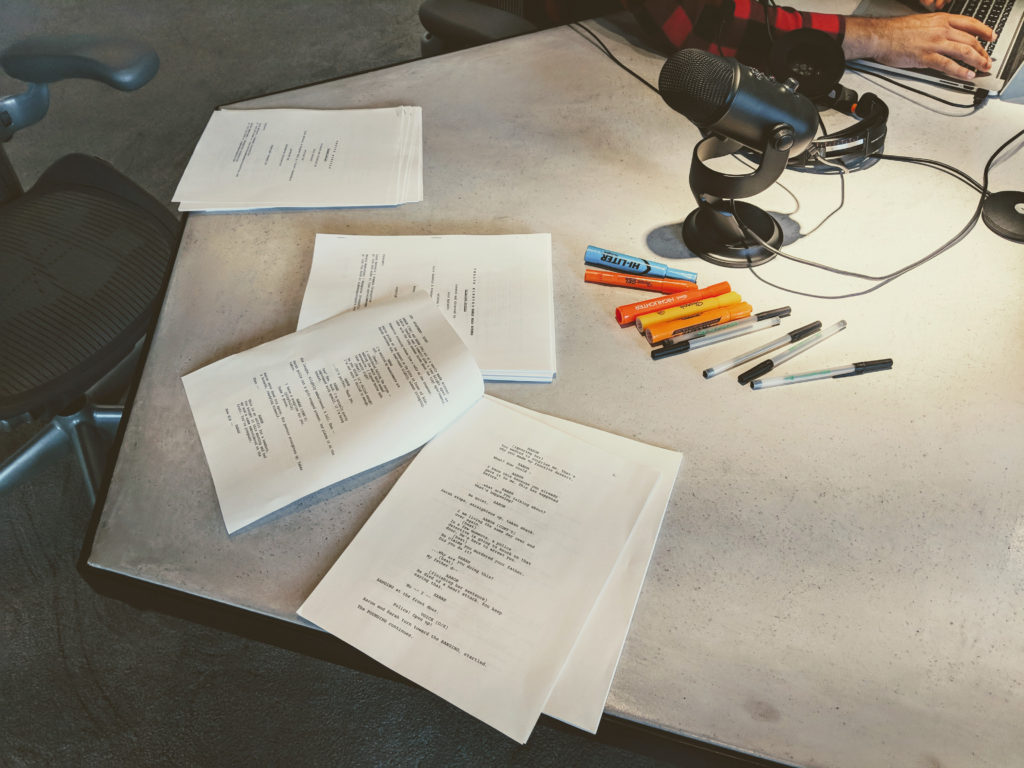
It was quite an experience, and we all agreed it would make the game stronger, so the next step was to see it in-game. We didn’t record the sit-down session, so I asked some of my neighbors to come to my place, record as many lines as possible, and export them to the engine. The result was once again positive, so the final step was creating a short slice of how it would all play out in the final product, leading to the E3 trailer.
Casting Process
Now that we had decided to record the voices for the characters, we had to figure out the unknowns of the process. The two main challenges were making the script accessible during a recording session (how to turn the non-linear flowchart format into a readable script) and understanding the logistics of the recording process (how many lines per session, how many sessions, etc.). And that is why we did a test recording VO session that I covered in a previous post answering most of these unknowns.
We were now ready to start the casting!
We wanted to find actors that fit the role, are interested in the material, and are comfortable with the lack of linearity during the recording process. Usually, for film, once an actor shows interest, you send them the full script, but in our case, that didn’t exist. Our dialogues are spread out through 11 different flowchart documents that get loaded into the engine. Here is how one of them looks like zoomed out:
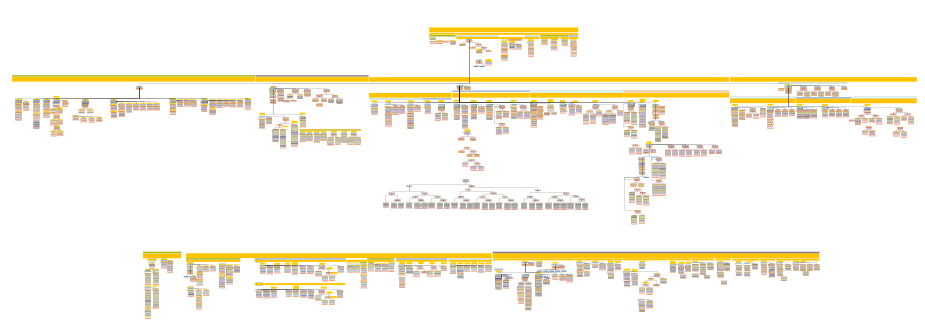
Even I sometimes have difficulty remembering what sequence is where, so this would be a problem for the actors. Our solution was to provide three separate documents, one for the character arc, another with the biography, and finally, the third one with some critical scenes converted into script format.
After getting our cast in place, and based on our previous test run, I assumed that I could share the gigantic flowcharts for the recording session. But once they asked to read the material to better prepare for the roles, we ran into the same issue.
Not only could they not prepare (which would affect the quality of the performance), but this unusual format would likely cause other issues. If we zoom out from the flowchart, how can we quickly find where we were? What if we want to jump between documents/scenes? How can the recording team label each Take? How can anyone but myself track where we are or even take notes from the session?
So a few weeks before our first session, we had to frantically convert EVERY SINGLE SCENE into a readable format. I cannot stress how incredibly time-consuming this process was. Still, in hindsight, it made a significant difference to the results we are getting.
The flowcharts are structured in a way that is easy for me to read, but not for an actor. Each exchange is usually grouped based on the current knowledge of a specific character in the loop.
For example, after the wife tells the husband (Player) that dinner is ready, he can say, “Let’s eat.” The variations of that exchange are grouped based on her knowledge up to that point in the loop. Is the player saying this before she even mentioned it? Did he manage to prove he is living the same day? Maybe someone rang at the doorbell? And so on.
In the image below, each column represents a variation on that same exchange depending on the knowledge:
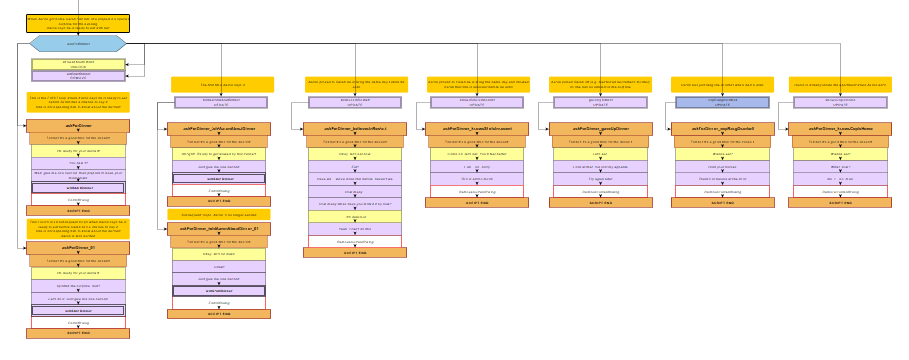 It’s much more beneficial for an actor to have his scenes organized by a specific emotional state, rather than the same scene in all its variations. They don’t need to jump from relaxed to stressed, back to happy, and then to frustrated every couple of lines allowing them to give a much more consistent performance based on the situation.
It’s much more beneficial for an actor to have his scenes organized by a specific emotional state, rather than the same scene in all its variations. They don’t need to jump from relaxed to stressed, back to happy, and then to frustrated every couple of lines allowing them to give a much more consistent performance based on the situation.
During this epic re-organization, we also changed the order of the scenes to create a semblance of chronology, allowing us for the first time to review the story in a much more organic way. We could ‘feel’ how many sequential moments play out and adjust specific lines, so it flows better. The eleven different flowcharts were sliced and reorganized in about twenty printable documents for each session with notes for every scene:
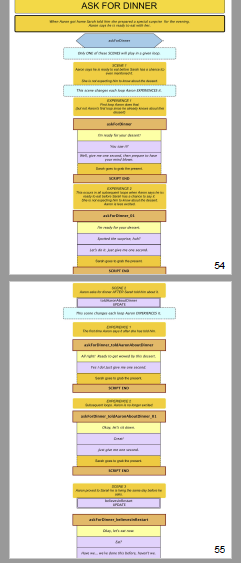
Table Read
Before we start recording, we schedule a Table-Reading session. A table read in movies means having the cast together for the first time, and everyone gets a feeling for the material, identifies any concerns with the script or any other development issues that become apparent.
In our case, we divided it into two parts. The first was more of an “Orientation” type of process. We went over all the material we had previously provided in a very condensed format (character beats and bios), the tone of the experience, and conveying the story in a linear form. We wanted them to be able to ‘be’ the characters since interiorizing the script was not feasible.
We also covered how to read these new ‘scripts’ since they are very different from a classical formatted script.
The second part was the actual table-read, using selected excerpts to create a sort of a linear narrative. And then the magic happened, we heard these three characters meet for the first time and saw them interact, it was a beautiful culmination of all the work up to that point!
Recording Process
After that, we started the recording sessions. The whole pipeline from recording to in-game is genuinely a superb team effort.
In the game, only two characters talk simultaneously, so we only have two actors each session.
Apart from them, here is the team during a recording session:
- Director – Guiding the session, explaining the setting for each scene, and making sure the lines have the tone we are aiming for.
- Voice Director – Helps translate the director’s character needs to the actors in a language they are comfortable with. Also makes sure we get enough variations for the editing process.
- Script Supervisor – Checks that we are following the script, tracks the number of takes, any lines we might have skipped, or moved for later if we are ok on time and any other logistics.
- Producer – Making sure the whole process is flowing between the actors, the directors, and the audio studio.
- Recording Booth Team– Recording and labeling all the audio files for processing after, working with the script supervisor. Also checking the voice levels and any other technical issues.
- Writer – Making sure the characters we wrote work at the micro and macro level and providing any character details that might pop up during the session.
Once a session as ended, the recording studio sends the raw data to an Audio Technician that slices up all the recordings based on the scene names in the document. Each scene has two tracks for each actor (they record on two microphones) and an additional track that composites both voices. This added track allows me to easily select what takes to use, or sometimes glue different parts of different takes.
Once the takes are selected, the Audio Engineer cleans the individual actor takes, normalizes the volume, fixes the timing, slices them based on the flowchart, renames them, and exports them to the game.
We then use a big spreadsheet that allows us to track the state of every scene. It’s crucial during the review process that we know what we are missing. We can approve the takes and know what lines might need to be re-recorded (The image below is small and blurry to avoid spoilers).

We also spaced out the recording schedule as much as possible, about a week and a half every two sessions. This allowed us enough time to implement the recorded material in-game, and learn from it in case adjustments are needed for the next sessions.
Finally, here are some questions that I often receive, and having them answered here could be helpful:
So…who are the actors?
We’ll share that soon.
What is the release date?
We’ll share that soon too. I want to make sure that we won’t miss it before announcing it.
Why does it take you so long between blog posts?
I’m often too busy or don’t really have any material that is not extremely spoiler heavy. Follow the twitter feed @12minutesgame for smaller updates.
Is it coming to the [my_favorite_platform]?
So far we’ve announced Xbox and Steam. More information will be released later.
This was a very interesting read 😀 Voice acting really impressed me during last year’s trailer and will definitely improve this experience greatly.
Can’t wait for the game to come out!
Really interesting. So excited for this game!!
Wait so hard for this game
I like your approach to game design (gameplay first). Too often games run into issues where they want to tell a certain story and then are limited by the gameplay. Your take on it is refreshing.
That does sound like a nightmare task. Hope you guys managed to get the results you were hoping for.
It was a lot of work, but not in a negative way (e.g.a nightmare). Seeing it all come to fruition is extremely gratifying.
I just want to say – I’ve been following the development of this game ever since I first saw the trailer at E3. I love reading your thought process behind the voice acting. You can tell how much heart is going into this just by how you’re handling even the voice acting. Keep up the amazing work!
This game looks awesome. Is it still coming to Xbox One?
Just so you know, I’ve been waiting for this game for over 5 years, and I’m still super excited to play it when it releases!
Desde que vi o jogo na expo de Las Vegas (se não estou em erro) que ando a segui-lo. Se calhar deves olhar para trás e pensar “epá, 6 anos…”. Aonde conseguiste chegar é incrivel, estás a caminho de ser um grande diretor e levar o nome português e marcá-lo na história gaming! É um jogo que mal saia, vou apresentar na twitch! Até ficaste boquiaberto com o elenco que tiveste, não? 😀